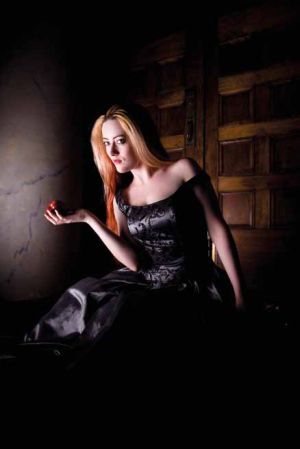articles/Lighting/lightingfordigitalpart18-page1
Lighting for Digital Part 18 - part 1 of 1 2 3
by Dave Montizambert Published 01/12/2010

Now let's get into action and try the Hue/Saturation skin-tone adjustment technique discussed in Part 1 of this article for real. Using model Renee Robyn as the subject (see Image 001), let's see if we can give this card-carrying Goth a sun-tan and keep it real (real looking that is) - a sacrilege I know but for the sake of the exercise. First off we need to see what her skin-tone values read in HSB and so the eyedropper tool is swept across her exposed flesh:
• H: 355° S: 8% B: 93% forehead.• H: 4° S: 14% B: 82% Renee's left shoulder.
• H: 358° S: 14% B: 87% under her right collarbone.
• H: 351° S: 14% B: 78% below her left elbow, inner arm
My first reading off the forehead reveals a really pale, cold, but bright skin-tone - 355° Hue is a very cold skin-tone. For accurate judgement of flesh-tone, this area is not that great a spot to read off. First of all readings from women's faces can be deceiving due to make-up which more often than not, is not the same as their real skin-tone. Secondly one should not base readings from flesh areas that are covered in specularity (shine). In this image, Renee is on an acute angle to the main light source which is placed a bit behind and to the camera-left side of her (see Image 002); this back lighting position was chosen because it creates a beautiful specular sheen over her. Judging skin-tones from sheen-covered flesh is pure folly, Hue values will always read more neutral than the real flesh is, saturation values will read lower, and brightness values artificially high. This isn't to say these areas with shine are wrong, it is just not a very good area to make an accurate assessment of true skin-tone. The optimum spots to read skin-tone from should be fully lit by the main light source and be devoid of specularity and make-up. I like to read from the chest, the neck, and the arms - when bare and available - and I like to read from multiple areas. I do also read off faces too, so as to see where they sit. In some cases I will make a separate localised correction for a face if it looks out of whack due to bad make-up or some other factor. A person's skin-tone will spread over a range of numbers and so taking readings is about identifying a range rather than a single skin-tone.
You are currently on page 1
- Lighting for Digital Part 18 page 1
- Lighting for Digital Part 18 page 2
- Lighting for Digital Part 18 page 3
1st Published 01/12/2010
last update 09/12/2022 14:55:51
More Lighting Articles
There are 0 days to get ready for The Society of Photographers Convention and Trade Show at The Novotel London West, Hammersmith ...
which starts on Wednesday 15th January 2025





